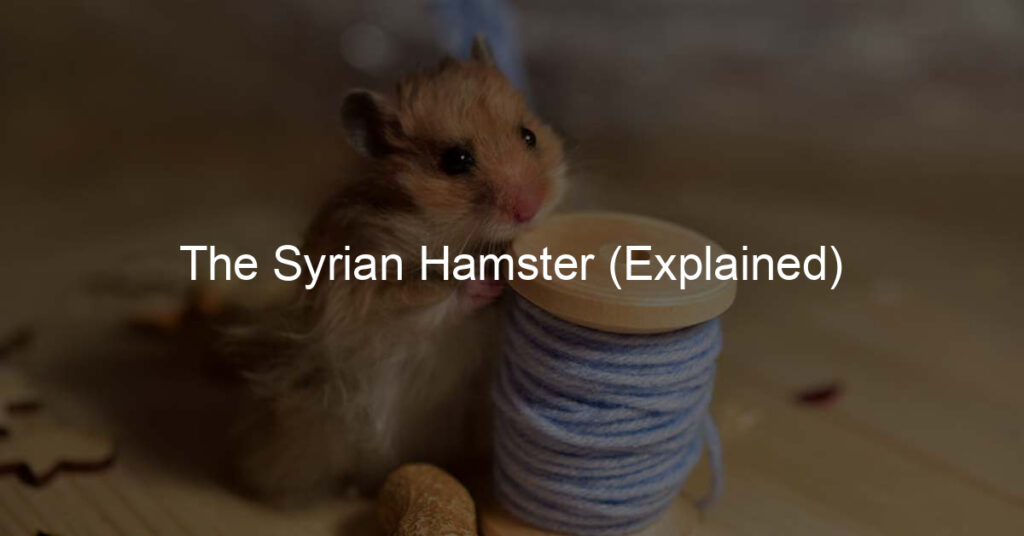Owning a hamster can be a remarkably satisfying experience. They are among the cutest rodents, making them popular choices for many of us to keep as pets.
The Syrian hamster is the preferred choice of pet owners in particular. Because of their snuggly and interacting personalities and behavior, these adorable, entertaining, and curious animals make the best pets.
It is sometimes referred to as a “teddy bear” because it is soft and likes to be held. But you should know a few things before considering adopting a Syrian hamster.
Why don’t you read on to find out more?
What is a Syrian Hamster?

Its scientific name, Mesocricetus auratus, is a Syrian hamster, and it was first discovered and given that name in the late 1800s.
Of the 20 species, the Syrian Hamster is among the most prevalent and the largest. The rodent family, which comprises 40 percent of the mammalian orders, includes them. Despite the average size of Syrian hamsters being around 20 cm, some have been known to reach 30 cm.
Is a Syrian Hamster a Good Pet?
Syrian hamsters are lovely pets. They have strong personalities and can be very active. If properly handled and raised, they will become lifelong friends. However, handling young hamsters can be challenging because they are still adapting to life outside.
Being prey animals, Syrian hamsters can become a little jittery when first exposed to loud noises, sudden movements, and touch.
Syrian Hamster Behavior
If your pet exhibits any of the behaviors listed below, it’s safe to assume that all is well in the hamster household.
- The hamster is a nocturnal creature. Have no fear if your hamster is awake and moving around in their habitat at night; this is a sign of a content hamster. They will work out for 3 to 4 hours every night because they have so much energy.
- When living in an environment where the temperature falls below 40 F, Syrian hamsters can enter a false hibernation. These hamsters might appear to be dozing off or dead during false hibernation.
- You should gradually increase the temperature in the area if you suspect that your pet hamster has gone into a false hibernation.
- Hamsters grind their teeth by chewing, which is a natural behavior for these tiny rodents. They can gnaw on crunchy food or wooden blocks.
- Hamsters store and transport food in their cheek pouches.
- They use the cheek pouches to carry their young, food, and occasionally bedding. They will take the filled cheek pouches back to their hole or designated hiding spot and empty the contents into their food store.
- Hamsters naturally conceal themselves or dig burrows as a form of defense. When they need to rest, they typically hide. This is how they keep themselves secure at night.
Are Syrian Hamsters the Friendliest?

Once domesticated, Syrian hamsters are typically amiable and a good choice in many nations because they can develop close relationships with their owners. Syrian hamsters are the biggest and among the most common pet hamsters, partly because of how easy it is to hold them due to their size.
These hamsters move more slowly compared to some of their relatively small relatives due to their size and chunkiness. Many people believe that because owners handle and play with them, they become a less stressful option.
Do Syrian Hamsters Bite?
Syrian hamsters only bite humans when they feel threatened despite having long, powerful teeth. They may become startled by fast movements or loud sounds and react by biting the danger. They might also bite careless owners.
Syrian hamsters, however, take pleasure in being handled by their owners without being overly restrained. Additionally, owners must keep in mind that grumpy hamsters can be sleepy. Your hamster might bite you if you startle it by waking it up. Therefore, wake them up gently.
Syrian Hamsters Lifespan

Knowing how long hamsters live is essential if you’re thinking about getting one. The typical lifespan of a Syrian hamster in the wild is two to three years.
They can live up to 3–4 years longer in captivity, though. The oldest Syrian hamster was 4.5 years old and belonged to Karen Smeaton of Tyne & Wear, United Kingdom.
Your hamster friend’s lifespan and health are influenced by several critical factors. Some of them are under your control, while others are not.
Syrian Hamster Colors
Hamsters come in various colors, sizes, and hair textures. Depending on where they were bred, different colors and textures are available. Hamsters bred in captivity for extended periods frequently have more forms available to choose from.
The Syrian hamster’s colors can be classified into self, agouti, or combinations.
- Self-colors have uniform coat colors, including the same shade for the topcoat and undercoat.
- Agouti hamsters have markings around their eyes and a different, lighter undercoat.
- Combinations are created when two or more self or agouti colors are present.
Final word
Now that you know the facts and information regarding these fur babies, it is up to you to decide whether to keep one of them as a house pet. No matter how busy your day is right now and in the future, adopting a Syrian Hamster doesn’t have to be stressful anymore.








